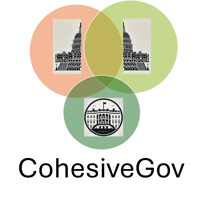The Complete Guide: How Standardized Initiatives, Dashboard, and Tools Work Together
As introduced on our home page, the Cohesive Government system integrates Standardized Initiatives, the Mission Areas Dashboard, and specialized tools to transform government operations. This page takes you 'inside the system,' offering a detailed, step-by-step look at how these components work together, from the initial concept of an initiative through to its completion. Following this structured process enhances clarity, boosts efficiency, fosters collaboration, and provides unprecedented public transparency. Understanding this workflow is key for both government teams implementing change and citizens monitoring progress towards a more accountable and effective government.
Step 1: Define the Initiative
The journey of any successful government action begins with a crucial first step: Defining the Initiative.
Before any work commences, it's essential to clearly establish the initiative's purpose, its scope (what's included and excluded), and the specific outcomes it aims to achieve. This foundational clarity prevents wasted effort and ensures all stakeholders are aligned. Key elements captured during this phase include the initiative's Vision, its Starting Point (the current baseline), and its measurable Goals. You can find detailed definitions for each element on our 'Learn About Initiatives' page:
To streamline this process and ensure consistency across all government actions, the system provides specialized tools and templates that guide users in capturing all necessary information in a standardized format.
Step 2: Developing the Action Plan (Roadmap)
Once an initiative's goals and scope are clearly defined, the next vital step is Developing the Action Plan (Roadmap). This detailed planning phase translates the initiative's vision into a concrete strategy for execution. It involves outlining the specific tasks required, assigning clear responsibilities, setting realistic timelines, allocating necessary resources (like budget and personnel), and proactively identifying potential risks and mitigation strategies. To facilitate this crucial step, the system offers integrated planning tools and templates, helping teams create comprehensive and effective roadmaps efficiently. A well-defined roadmap is critical; it serves as the guide for implementing the initiative, ensures clarity for all involved, and provides the structure needed for accurately measuring progress against objectives.
Step 3: Publishing the Initiative
With the initiative defined and the roadmap planned, the third step is Publishing the Initiative to the central system. This involves formally entering all the essential details – including the vision, goals, starting point, metrics, and the complete action plan – into the system using a standardized format. This publishing step is pivotal for transparency; it instantly makes the initiative, its objectives, and planned roadmap visible and accessible to all interested parties through the public-facing Mission Areas Dashboard. By making this information public from the outset, the system fosters accountability and ensures everyone can track the initiative from its very beginning acting as a universal standard for communication and collaboration across government.
Step 4: Executing and Tracking Progress
Following publication, the initiative moves into the active phase: Executing and Tracking Progress. Government teams begin implementing the specific tasks and actions detailed in the initiative's roadmap, working towards the defined goals. Throughout this phase, the Mission Areas Dashboard serves as the central hub for monitoring and transparency. Teams continuously update key performance metrics and status information (such as 'On Track,' 'At Risk,' or 'Delayed') directly within the system as milestones are reached or challenges arise. This ensures the dashboard provides real-time visibility into performance for both internal government teams and the public, promoting accountability. This shared, up-to-date view allows everyone to identify potential roadblocks early, fosters collaboration across involved units, and enables timely, data-informed adjustments to keep the initiative on course.
Step 5: Reviewing, Reporting, and Closing
The final stage in the initiative lifecycle is Reviewing, Reporting, and Closing. Regular reviews are essential to ensure initiatives remain effective and deliver value. Using the up-to-date data readily available on the Mission Areas Dashboard, teams and stakeholders can assess performance against goals and make informed decisions about any necessary adjustments. The system also streamlines the creation of standardized performance reports, which can be easily shared internally and with the public to maintain transparency. Once an initiative successfully achieves its defined goals, it undergoes a formal closing process. This involves documenting the final outcomes, lessons learned, and overall impact, ensuring this crucial information is archived within the system and remains publicly accessible for future reference and accountability.
